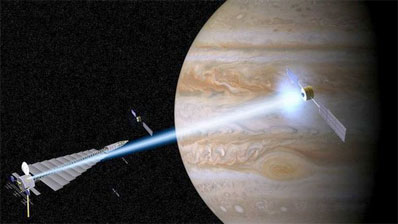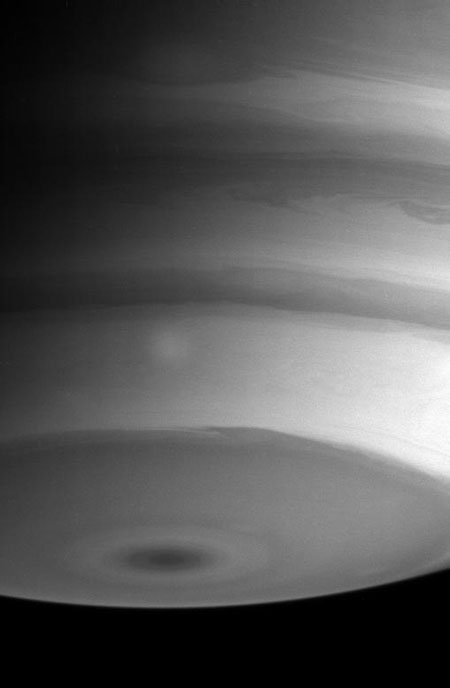Is a 90-day Mars round trip possible via new propulsion?UNIVERSITY OF WASHINGTON NEWS RELEASE
Posted: October 16, 2004
A new means of propelling spacecraft being developed at the University of Washington could dramatically cut the time needed for astronauts to travel to and from Mars and could make humans a permanent fixture in space.

In this artist's conception, a plasma station (lower left) applies a magnetized beam of ionized plasma to a spacecraft bound for Jupiter. Credit: John Carscadden, University of Washington
|
In fact, with magnetized-beam plasma propulsion, or mag-beam, quick trips to distant parts of the solar system could become routine, said Robert Winglee, a UW Earth and space sciences professor who is leading the project.
Currently, using conventional technology and adjusting for the orbits of both the Earth and Mars around the sun, it would take astronauts about 2.5 years to travel to Mars, conduct their scientific mission and return.
"We're trying to get to Mars and back in 90 days," Winglee said. "Our philosophy is that, if it's going to take two-and-a-half years, the chances of a successful mission are pretty low."
Mag-beam is one of 12 proposals that this month began receiving support from the National Aeronautics and Space Administration's Institute for Advanced Concepts. Each gets $75,000 for a six-month study to validate the concept and identify challenges in developing it. Projects that make it through that phase are eligible for as much as $400,000 more over two years.
Under the mag-beam concept, a space-based station would generate a stream of magnetized ions that would interact with a magnetic sail on a spacecraft and propel it through the solar system at high speeds that increase with the size of the plasma beam. Winglee estimates that a control nozzle 32 meters wide would generate a plasma beam capable of propelling a spacecraft at 11.7 kilometers per second. That translates to more than 26,000 miles an hour or more than 625,000 miles a day.
Mars is an average of 48 million miles from Earth, though the distance can vary greatly depending on where the two planets are in their orbits around the sun. At that distance, a spacecraft traveling 625,000 miles a day would take more than 76 days to get to the red planet. But Winglee is working on ways to devise even greater speeds so the round trip could be accomplished in three months.
But to make such high speeds practical, another plasma unit must be stationed on a platform at the other end of the trip to apply brakes to the spacecraft.
"Rather than a spacecraft having to carry these big powerful propulsion units, you can have much smaller payloads," he said.
Winglee envisions units being placed around the solar system by missions already planned by NASA. One could be used as an integral part of a research mission to Jupiter, for instance, and then left in orbit there when the mission is completed. Units placed farther out in the solar system would use nuclear power to create the ionized plasma; those closer to the sun would be able to use electricity generated by solar panels.
The mag-beam concept grew out of an earlier effort Winglee led to develop a system called mini-magnetospheric plasma propulsion. In that system, a plasma bubble would be created around a spacecraft and sail on the solar wind. The mag-beam concept removes reliance on the solar wind, replacing it with a plasma beam that can be controlled for strength and direction.
A mag-beam test mission could be possible within five years if financial support remains consistent, he said. The project will be among the topics during the sixth annual NASA Advanced Concepts Institute meeting Tuesday and Wednesday at the Grand Hyatt Hotel in Seattle. The meeting is free and open to the public.
Winglee acknowledges that it would take an initial investment of billions of dollars to place stations around the solar system. But once they are in place, their power sources should allow them to generate plasma indefinitely. The system ultimately would reduce spacecraft costs, since individual craft would no longer have to carry their own propulsion systems. They would get up to speed quickly with a strong push from a plasma station, then coast at high speed until they reach their destination, where they would be slowed by another plasma station.
"This would facilitate a permanent human presence in space," Winglee said. "That's what we are trying to get to."
Interesting.
Thanks for the ping.


